Britain’s biggest brands are entering uncharted waters. As a price war threatens to engulf the leading supermarket chains, and volumes shift to the discounters, the hunt for growth is more imperative than ever. Some are leaping into new categories, some are embracing new channels, while others are setting sail for new shores altogether.
With mixed results: 34 of The Grocer’s 100 Biggest Grocery Brands have suffered value losses in the past year, compared with 26 last year, our analysis shows. Nevertheless, the top 100 have achieved growth of £418.7m (2.1%) between them, bringing their combined value to an impressive £20bn.
See the complete list of Britain’s 100 Biggest Grocery Brands
Of course, inflation has played a part in this. As the cost of many commodities – particularly meat and grain – has risen, some brands have pushed up prices considerably. And those that haven’t done enough to justify the premium they invariably carry have suffered. Volume sales have fallen for 45 of the top 100. So who’s leaking water?
Cadbury Dairy Milk (5) is captain’s mate, adding a staggering £61.6m in incremental sales. The growth, says Mondelez’s marketing director for chocolate Matthew Williams, has been driven by 16 new launches under the Dairy Milk brand in the past year.
And it hasn’t been afraid to raise a few eyebrows. “Today, NPD is about blowing apart category boundaries, bringing together sweet, savoury, sour and salty in new and exciting ways,” says Williams, pointing to last year’s launch of combinations including Dairy Milk with salted pretzels & cola pieces or candy shell popping candy, under the Marvellous Creations banner, which is now worth £46m to Dairy Milk.
Mondelez isn’t just merging categories; its brands are being blurred too. While this trend raises new challenges for anyone attempting to measure the value of brands, it’s a key engine of growth: Dairy Milk variants with Oreo and Daim (included under Dairy Milk for the purposes of this report) have racked up nearly £25m between them in the past year, for example.
“Combining brands offers an exciting opportunity to boost sales and capitalise on the reputation of each…”
Matthew Williams, Mondelez
“Combining such popular brands offers an exciting opportunity for retailers to help boost sales and capitalise on the phenomenal reputation of each brand individually, opening up a much larger market and encouraging impulse purchases,” says Williams. “The cross-category innovation is set to continue into 2014. Already, we’ve brought to market two new countlines – Cadbury Dairy Milk LU and Cadbury Dairy Milk Ritz.”
Mondelez has also found growth for Philadelphia (79) by moving it into cooking sauces with the March 2013 launch of Simply Stir, a move Mondelez says has since netted £6.4m. And Innocent’s (29) jump into adjacent and non-adjacent categories has helped it offset declining smoothie sales.
For Special K (52) the leap into new categories has meant the difference between growth and loss. The brand has offset soggy cereal sales, down 2.2%, with launches into everything from bagged snacks to porridge. The overall brand is up 7%.
“Special K is Kellogg’s biggest brand and traditionally has been known for adult health, but because the brand is so strong we are now able to take it in different directions,” says Kellogg’s corporate affairs director Paul Wheeler. “People who love the brand can now enjoy it throughout the day with a wide range of cereal bars plus Cracker Crisps, so we’re giving numerous options to suit their needs.”
Weetabix (53) has followed suit and reports strong sales of On The Go biscuits, which it launched in January 2013 (though the overall brand is still in decline), and has high hopes for the breakfast drink it launched this year. Tropicana (16) is meanwhile trialling a juice/energy drink hybrid in Tesco. And Cathedral City (18) is targeting £10m sales for its Baked Bites biscuits (made under licence by Burton’s) within a year of their September launch.
Of course NPD, whether within familiar territories or not, isn’t the only path to growth.
“It’s all about having the right offering in each channel,” says Ian Morley, commercial director for household at P&G. “People now shop in traditional grocers and grocery and high street discounters. Traditional grocers have to work harder than ever before to grow, but it’s still possible. For example, we’ve grown Fairy Liquid by offering the right, tailored range, and price and promotions for these important retailers.”
“We’re focused on offering the right pack mix… meeting consumer price points is key”
Nick Canney, Coca-Cola Enterprises
As a result, the overall Fairy brand (12) has achieved growth of 1.7% on unit sales up 6.1%. The gulf between Fairy’s value and unit sales growth in part reflects the growing trade Morley says the brand is doing through the discounters. But there’s another channel that is having a huge impact on the fortunes of grocery’s biggest brands: convenience.
Impulse
Take Coke (1). “We’re focused on offering the right pack mix for the right shopper environment – a key driver for Coke has been launching the 250ml format into the convenience sector and we’re about to launch a new pack (the 1.75 litre contour bottle) into the main part of grocery,” says Nick Canney, VP for sales at Coca-Cola Enterprises. Of course, price has been a key factor here. “There’s no doubt about it: it’s a tough environment and meeting consumer price points is key.”
As Coke cut the size of its packs, size still matters for rival Pepsi (9), which in January last year rebranded its 600ml impulse bottles with a flash highlighting that the format is 20% bigger than the standard 500ml offering. The move has driven growth at two and a half times the rate of the wider cola singles market and resulted in nearly £6m of incremental growth in its first nine months, says Pepsi’s bottler Britvic.
Nevertheless, Coke’s absolute growth of £34.3m (the third highest in grocery) is more than three times that of Pepsi’s, thanks in part to a master stroke in branding, which was… erm… to remove the brand name. Last April, CCE replaced the Coke logo on 500ml and 375ml bottles of Coke, Diet Coke and Coke Zero with 100 of the most popular first names in the country and later added another 150 names to the line up.
“It went down a storm,” says Canney. “It created a huge amount of interest in the fixture. We had people actively looking for their names in the chillers and really engaging with the brand. We achieved something no other brand has done before. That’s exactly what a brand of Coke’s scale should be doing.”
It’s clear that good, old-fashioned branding can still help drive growth. CCE’s Monster Energy (91) has broken into the Top 100 with the greatest percentage value increase (23.1%) in the ranking, thanks to its close associations with motor sports, its youth-orientated branding and a raft of NPD. Sponsorship of everything from F1 to soap-box cart racing – and of course the launch of the Editions range in January last year – has meanwhile helped Red Bull (20) deliver 6.8% value growth.
“It’s been a challenging year… there’s been significant investment in ‘healthier’ own label”
Matthew Davis, WeightWatchers
Such activity is essential if brands are to stop shoppers from turning to cheaper alternatives. One such brand that’s suffered in this respect is WeightWatchers (32), which has seen sales fall £48.9m (19.9%) across its grocery lines, losing it 11 places in the ranking.
Recovery plans
WeightWatchers has a plan, says UK head of licensing Matthew Davis: “It’s been a challenging year for many in the diet category. We’ve seen consumers spending less on reduced-calorie foods and there’s been significant investment in ‘healthier’ own-label ranges. WeightWatchers’ significant investment in the brand in 2014 demonstrates our commitment.”
To an extent, WeightWatchers has been a victim of changing consumer tastes. Many now view foods with more wholesome images, such as butter – both butter brands in the top 100, Lurpak (14) and Anchor (72), are in growth – as better for you than foods that have been manufactured specifically to be healthier. Flora’s (38) decline of 11.5% on volume down 15.1% bears this out.
The entry of Alpro (100) to the ranking is another milestone. “We’re recognised as a brand that can provide functional benefits and a positive health choice,” says Alpro marketing director Tim Smith, adding that a third of the brand’s consumers are not dairy intolerant, showing it’s now graduated into the mainstream. “Our ambition is to double the size of the brand, without a crystal ball, within three to five years.”
Of course, simply being fashionable won’t be enough to realise such ambitions, as the growth of Anchor (partly down to expansions into cheese and pastry) and Lurpak (aided by homebaking-themed ads) proves. Over the next three years Alpro will be focusing on more premium products, particularly chilled desserts, in a bid to accelerate growth, says Smith.
Similar plans will be afoot at Hovis (11) – the biggest casualty of the year with losses of £55.7m (13.4%) – after the January formation of the Premier Foods/Gores Group joint venture Hovis Ltd and the allocation of a £200m investment fund. With much of Warburtons’ (2) and Kingsmill’s (6) growth coming from bread alternatives and bagged snacks, diversification away from the sliced bread sector could well be a priority.
As with all of Britain’s biggest brands, for Hovis growth will rely on an ability to steward the ship through today’s shark-infested waters with skill, and a willingness to search for treasure wherever it may lie. Any brand manager who fails to do so will end up walking the plank.
See the complete list of Britain’s 100 Biggest Grocery Brands
| RANK | BRAND | |
|---|---|---|
| 2014 | 2013 | |
| 1 | 1 | COCA COLA |
| 2 | 2 | WARBURTONS |
| 3 | 3 | WALKERS |
| 4 | 4 | BIRDS EYE |
| 5 | 5 | CADBURY DAIRY MILK BRAND |
| 6 | 8 | KINGSMILL |
| 7 | 7 | NESCAFE |
| 8 | 9 | LUCOZADE |
| 9 | 11 | PEPSI COLA |
| 10 | 10 | ANDREX |
| 11 | 6 | HOVIS |
| 12 | 12 | FAIRY |
| 13 | 15 | MCCAIN POTATO PRODUCTS |
| 14 | 14 | LURPAK BUTTER |
| 15 | 16 | ROBINSONS |
| 16 | 17 | TROPICANA |
| 17 | 18 | PRINCES |
| 18 | 19 | CATHEDRAL CITY |
| 19 | 13 | WHISKAS LOCAL BRAND |
| 20 | 23 | RED BULL |
| 21 | 22 | PERSIL |
| 22 | 20 | GALAXY BRAND |
| 23 | 29 | MULLER CORNER |
| 24 | 24 | HEINZ SOUP |
| 25 | 27 | FELIX LOCAL BRAND |
| 26 | 33 | CADBURY BRAND |
| 27 | 26 | HEINZ BEANS |
| 28 | 25 | ACTIVIA |
| 29 | 28 | INNOCENT |
| 30 | 30 | PEDIGREE LOCAL BRAND |
| 31 | 35 | WRIGLEY’S EXTRA |
| 32 | 21 | WEIGHTWATCHERS |
| 33 | 37 | AUNT BESSIES |
| 34 | 36 | HEINZ SAUCE |
| 35 | 31 | KIT KAT |
| 36 | 42 | MALTESERS BRAND |
| 37 | 34 | ARIEL |
| 38 | 32 | FLORA |
| 39 | 39 | DORITOS |
| 40 | 48 | PRINGLES |
| 41 | 49 | MULLER LIGHT |
| 42 | 38 | JOHN WEST |
| 43 | 46 | RIBENA |
| 44 | 45 | CRAVENDALE MILK |
| 45 | 60 | VOLVIC |
| 46 | 40 | MR KIPLING |
| 47 | 43 | DOLMIO |
| 48 | 44 | NAPOLINA |
| 49 | 41 | P G TIPS |
| 50 | 54 | RICHMOND |
| 51 | 53 | COMFORT |
| 52 | 55 | SPECIAL K |
| 53 | 47 | WEETABIX |
| 54 | 66 | MCVITIES DIGESTIVES |
| 55 | 51 | VELVET |
| 56 | 52 | SCHWEPPES |
| 57 | 58 | YOUNG’S |
| 58 | 57 | FINISH |
| 59 | 69 | MAGNUM |
| 60 | 61 | LENOR |
| 61 | 59 | UNCLE BENS |
| 62 | 70 | FANTA |
| 63 | 56 | BOLD |
| 64 | 63 | KENCO |
| 65 | 67 | SURF |
| 66 | 68 | BAKERS LOCAL BRAND |
| 67 | 65 | MARS BRAND |
| 68 | 64 | DURACELL |
| 69 | 50 | SILVER SPOON |
| 70 | 82 | QUAKER OATS |
| 71 | 74 | HARIBO GUMS & JELLIES BRAND |
| 72 | 71 | ANCHOR |
| 73 | 85 | YEO VALLEY ORGANIC |
| 74 | 86 | EVIAN |
| 75 | 76 | HELLMANNS |
| 76 | 62 | TETLEY |
| 77 | 75 | TATE & LYLE |
| 78 | 77 | KLEENEX |
| 79 | 73 | PHILADELPHIA |
| 80 | 83 | DAIRYLEA |
| 81 | 79 | AIRWICK |
| 82 | 80 | WISEMAN MILK |
| 83 | 78 | MCCOYS |
| 84 | 87 | ROWNTREE |
| 85 | 94 | TWININGS |
| 86 | 81 | CHICAGO TOWN PIZZA |
| 87 | 88 | IRN BRU |
| 88 | 92 | KETTLE |
| 89 | 84 | GINSTERS |
| 90 | 95 | POT NOODLE |
| 91 | 114 | MONSTER |
| 92 | 93 | PIZZA EXPRESS |
| 93 | 91 | CLOVER |
| 94 | 98 | MCVITIES BISCUITS |
| 95 | 107 | KELLOGGS CRUNCHY NUT |
| 96 | 100 | SNICKERS BRAND |
| 97 | 97 | HULA HOOPS |
| 98 | 108 | OLD EL PASO |
| 99 | 99 | CAPRI SUN |
| 100 | 102 | DR PEPPER |
See the complete list of Britain’s 100 Biggest Grocery Brands







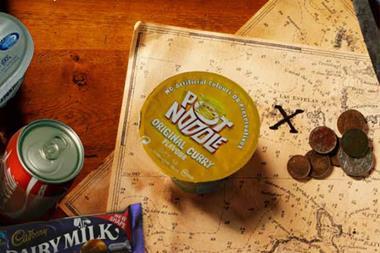
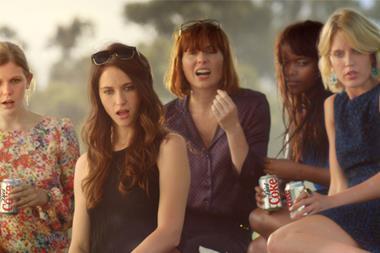
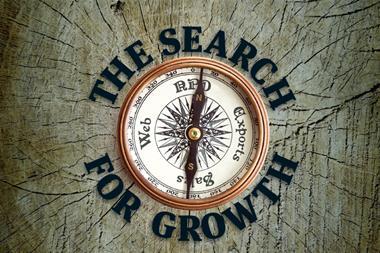

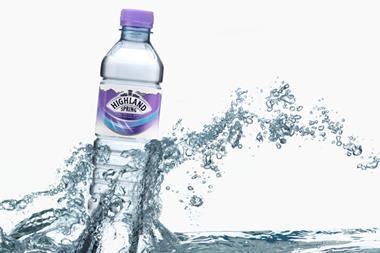

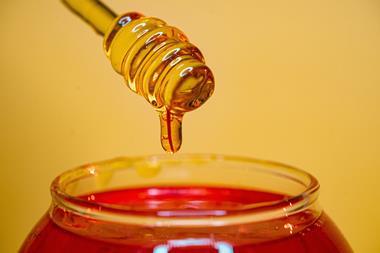
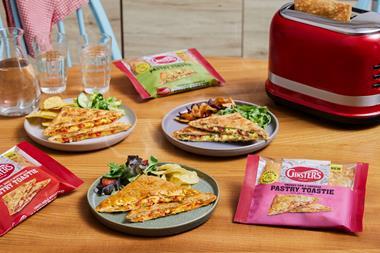

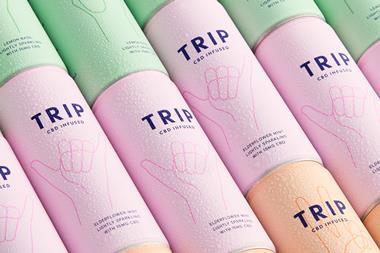
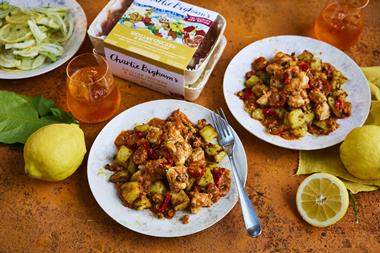
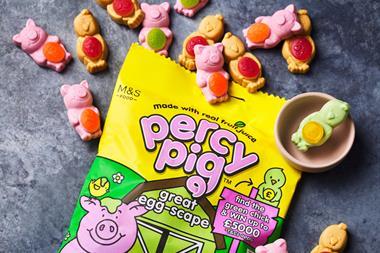
No comments yet